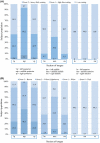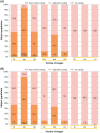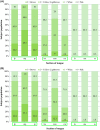Tongue coating in relationship to gender, plaque, gingivitis and tongue cleaning behaviour in systemically healthy young adults
- PMID: 31309703
- PMCID: PMC7004167
- DOI: 10.1111/idh.12416
Tongue coating in relationship to gender, plaque, gingivitis and tongue cleaning behaviour in systemically healthy young adults
Abstract
Objectives: The purpose of this observational study was to investigate the relationship between tongue coating (thickness [Tc] and surface discoloration [Td]) and gender, plaque, gingivitis (bleeding on marginal probing [BOMP] and bleeding on pocket probing [BOPP]) and tongue cleaning behaviour.
Materials and methods: A total of 336 participants were screened for this cross-sectional study, from which 268 (150 male, 118 female) were found to be eligible. Aspects of tongue coating were visually assessed. Additionally, BOMP, BOPP and the plaque index (PI) were scored. To ascertain the tongue cleaning behaviour, the Oral Hygiene Behavior questionnaire was used.
Results: Most tongue coating was found at the posterior sections of the tongue surface. A thin coating and white discoloration were most prevalent as highest score for both males (92.7%) and females (87.4%), as well as white discoloration for the whole group of participants (50.2%). A gender difference was observed for TC and Td (P < .001). Analysis did not reveal a relationship between Tc and PI and between Td and PI. Also, no relation was detected between tongue cleaning behaviour and Tc or Td. However, tongue cleaning was associated with lower BOMP and BOPP scores.
Conclusion: BOMP, BOPP or PI score did not appear to be linked to Tc and Td. A significant gender difference was found for Tc and Td. Self-reported tongue cleaning behaviour was associated with slightly lower BOMP and BOPP scores.
Keywords: bleeding; cross-sectional study; gingivitis; oral hygiene behaviour; plaque; tongue coating thickness; tongue surface discoloration.
© 2019 The Authors. International Journal of Dental Hygiene published by John Wiley & Sons Ltd.
Conflict of interest statement
The authors declare no conflict of interest to this study.
Figures



References
-
- Yaegaki K, Sanada K. Biochemical and clinical factors influencing oral malodor in periodontal patients. J Periodontol. 1992;63(9):783‐789. - PubMed
-
- Quirynen M, Mongardini C, Van Steenberghe D. The effect of a 1‐stage full‐mouth disinfection on oral malodor and microbial colonization of the tongue in periodontitis. A pilot study. J Periodontol. 1998;69(3):374‐382. - PubMed
-
- Mantilla Gómez SM, Danser MM, Sipos PM, Rowshani B, Van Der Velden U, Van Der Weijden GA. Tongue coating and salivary bacterial counts in healthy/gingivitis subjects and periodontitis patients. J Clin Periodontol. 2001;28:970‐978. - PubMed
-
- Simón‐Soro A, Tomás I, Cabrera‐Rubio R, Catalan MD, Nyvad B, Mira A. Microbial geography of the oral cavity. J Clin Periodontol. 2013;92(7):616‐621. - PubMed
-
- Chen ZL, Hu QF. Recent development in research on tongue inspection. Chin Med J. 1986;99(6):444‐456. - PubMed
Publication types
MeSH terms
Grants and funding
LinkOut - more resources
Full Text Sources
Research Materials
Miscellaneous

